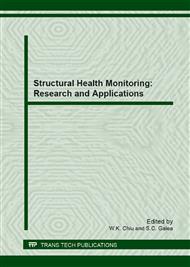p.477
p.489
p.501
p.510
p.522
p.534
p.546
p.554
p.561
Applications of Compressive Sensing Technique in Structural Health Monitoring
Abstract:
Compressive sampling also called compressive sensing (CS) is a emerging information theory proposed recently. CS provides a new sampling theory to reduce data acquisition, which says that sparse or compressible signals can be exactly reconstructed from highly incomplete random sets of measurements. CS broke through the restrictions of the Shannon theorem on the sampling frequency, which can use fewer sampling resources, higher sampling rate and lower hardware and software complexity to obtain the measurements. Not only for data acquisition, CS also can be used to find the sparse solutions for linear algebraic equation problem. In this paper, the applications of CS for SHM are presented including acceleration data acquisition, lost data recovery for wireless sensor and moving loads distribution identification. The investigation results show that CS has good application potential in SHM.
Info:
Periodical:
Pages:
561-566
Citation:
Online since:
June 2013
Authors:
Price:
Сopyright:
© 2013 Trans Tech Publications Ltd. All Rights Reserved
Share:
Citation:


